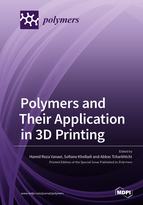Polymers and Their Application in 3D Printing
A special issue of Polymers (ISSN 2073-4360). This special issue belongs to the section "Polymer Physics and Theory".
Deadline for manuscript submissions: closed (15 November 2022) | Viewed by 39268
Special Issue Editors
Interests: additive manufacturing; 3D printing of polymers; 3D bioprinting; rheology of materials; mechanics of materials
Special Issues, Collections and Topics in MDPI journals
Interests: CFD; computational aeroacoustics; complex fluid flows
Special Issues, Collections and Topics in MDPI journals
Interests: polymers and composites; polymer processing; mechanical properties; solid mechanics; fracture mechanics; material characterization; additive manufacturing
Special Issues, Collections and Topics in MDPI journals
Special Issue Information
Dear Colleagues,
Fused filament fabrication, also known as 3D printing, is extensively used to produce prototypes for applications in, e.g., the aerospace, medical, and automotive industries. In this process, a thermoplastic polymer is fed into a liquefier that extrudes a filament while moving in successive X–Y planes along the Z direction to fabricate a 3D part in a layer-by-layer process. Due to the progressive advances of this process in industry, the application of polymeric (or even composite) materials have received much attention. Researchers and industries now engage in 3D printing by implementing numerous polymeric materials in their domain. In this Special Issue, we will present a collection of recent and novel works regarding the application of polymers in 3D printing.
Dr. Hamid Reza Vanaei
Prof. Dr. Sofiane Khelladi
Prof. Dr. Abbas Tcharkhtchi
Guest Editors
Manuscript Submission Information
Manuscripts should be submitted online at www.mdpi.com by registering and logging in to this website. Once you are registered, click here to go to the submission form. Manuscripts can be submitted until the deadline. All submissions that pass pre-check are peer-reviewed. Accepted papers will be published continuously in the journal (as soon as accepted) and will be listed together on the special issue website. Research articles, review articles as well as short communications are invited. For planned papers, a title and short abstract (about 100 words) can be sent to the Editorial Office for announcement on this website.
Submitted manuscripts should not have been published previously, nor be under consideration for publication elsewhere (except conference proceedings papers). All manuscripts are thoroughly refereed through a single-blind peer-review process. A guide for authors and other relevant information for submission of manuscripts is available on the Instructions for Authors page. Polymers is an international peer-reviewed open access semimonthly journal published by MDPI.
Please visit the Instructions for Authors page before submitting a manuscript. The Article Processing Charge (APC) for publication in this open access journal is 2700 CHF (Swiss Francs). Submitted papers should be well formatted and use good English. Authors may use MDPI's English editing service prior to publication or during author revisions.
Keywords
- 3D printing
- polymer characterization
- turbomachinery
- rheology
- 3D printed rotor









